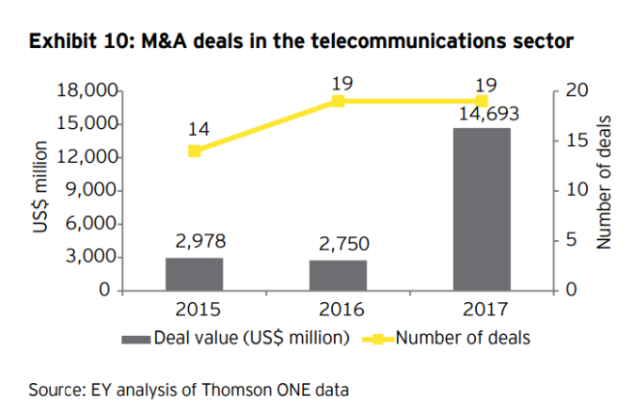This article is written by Kashish Khattar, Amity Law School, Delhi [IPU], currently enrolled in the Ace your Internship course at Lawsikho.
Introduction
India is currently the world’s second-largest telecommunications market with a subscriber base of 1.19 billion and has registered strong growth in the past decade and half. The Indian mobile economy is growing rapidly and will contribute substantially to India’s Gross Domestic Product (GDP), according to report prepared by GSM Association (GSMA) in collaboration with the Boston Consulting Group (BCG). The country is the fourth largest app economy in the world.
Motives for M&A in the Telecom Sector
-
Foreign Players willing to enter India
India being a big market for telecom has attracted attention of many foreign players. Due to expectation of growth and profitability in Indian Telecom Sector, many foreign players entered India. As it is not easy to start afresh because of spectrum limitation and other entry barriers, the foreign players have used mergers and acquisitions to expand its footprints in India.
-
Inorganic Subscriber Growth
Telecom sector in India is quite competitive. It is difficult for smaller players to compete with biggies. The big players are also keen on acquiring the customers of smaller players as the market is getting saturated.
-
Rapid change in Technology
Telecom sector has witnessed a rapid change in technology like 2G, 3G and 4G. So, to achieve economies of learning, firms are going for M&A. Indian Telecom firms are acquiring smaller companies to learn future technology.
-
Acquisition of Brand Value
Brand Name plays an important role in Indian Telecom Industry. Smaller firms can benefit a lot by merging with bigger names.
-
Limited Spectrum
India is divided into 22 circles. Each circle has limited amount of spectrum to be allocated to different players in each of 2G, 3G and 4G Technology. So to grow, it is important to acquire spectrums of other players. M&As are an easy tool to achieve this.
-
Advent of Reliance Jio
After Reliance Jio Infocomm Ltd started services in September 2016, giving a lifetime free voice calls and 3 months of free data (which was later extended till June 2017), M&As had become unavoidable in India’s hyper-competitive telecom industry. Idea Cellular and Vodafone Group Plc.’s Indian unit said they had decided to merge in a $23-billion deal to create the world’s 2nd largest and India’s largest telecom company. Although they played down the Jio factor as a motive for the merger, it’s clear that India’s No.2 and No.3 telcos had decided that, united, they had a chance of better contending with Ambani, who has so far invested $20 billion in the network. Market Leader, Bharti Airtel Ltd also reacted to it. Just 3 days after the declaration of the Idea-Vodafone merger, Bharti Airtel decided to buy Tikona Digital Networks Pvt. Ltd’s 4G business, including its broadband wireless access spectrum and 350 cellular sites in 5 telecom circles, for approximately Rs1,600 crore.
Therefore, EY has also said in one of it’s reports that the Indian telecoms market will shift from a fragmented mobile services industry with multiple operators to a more balanced market with three to four strong players. Consolidation will be taking a firm shape in 2018 and the new National Telecom Policy, 2018 will be a catalyst.
M&A Statistics
Indian telecom sector recorded $14.7 billion worth M&A deals in 2017 — more than 5-fold increase from 2016. The number of telecom M&A deals in India was 19, the same as the last year. The majority of the transactions were domestic in nature, accounting for 92 percent of the sector’s deal value and 58 percent of the deal count, according to consultancy firm EY.
Legal & Regulatory Framework related to M&A in the Telecom Sector
-
National Telecom Policy, 2012 has simplified M&A in Telecom Service Sector while ensuring adequate competition. 100% FDI is allowed.
- The merger of licenses shall be for respective service category. An access service license allows provision of internet service, the merger of ISP license with services license shall also be permitted.
- In a service area, market share of merged entity should be less than 50%. (earlier it as only 35%) if it is more, it has to reduce it below 50% in 1 year. For calculation of market share, both subscriber base & adjusted gross revenue will be considered.
- Total spectrum held by merged entity should be less than 50% in a service area. If it is excess, it has to be surrendered within 1 year.
- An acquirer will have to pay the differential between the auction-determined market price & the administrative price for anything beyond 4.4 MHz in the GSM band and 2.5 MHz in CDMA, if an acquired company has got spectrum after paying administrative price.
- If due to merger/transfer of license in any service area, any entity becomes a “significant market power”, then TRAI’s Telecommunication Act of 2002 will come into place. It will take steps so as to reduce its market power.
The major M&A deals in the Telecom sector in 2017-18
- Bharti Airtel agreed to buy Norway-based Telenor’s India unit in February to enhance its customer base and network.
- UK-based Vodafone and Indian telecom operator Idea Cellular signed $11.6 billion merger agreement in March to combine their Indian operations (excluding Vodafone’s 42 percent stake in Indus Towers) to become the largest telecom operator in India.
- Bharti Airtel agreed to buy Tikona Digital Networks’ 4G business, including its broadband wireless access spectrum and 350 cellular sites in five telecom circles, in a deal valued at $244.5 million.
- Airtel also decided to acquire Tata Teleservices and Tata Teleservices Maharashtra’s consumer mobile business. Tata Teleservices will retain its enterprise business as part of the deal.
- Reliance Jio agreed to buy the wireless spectrum, tower assets, optical fiber network and media convergence node assets of Reliance Communications. Anil Ambani is looking for a lean organization to focus on 4G.
- Vodafone India and Idea Cellular sold their tower business to American Tower Corporation Telecom Infrastructure for $1.2 billion.
- Bharti Airtel’s tower arm Bharti Infratel Ltd and Indus Towers have announced a merger which will create a pan-India tower company with a combined revenue of Rs25,360 crore, with over 163,000 towers, operating across all 22 telecom service areas in India.
Airtel Telenor Deal: A closer analysis
Telenor India announced a merger with Bharti Airtel, which will boost Airtel’ subscriber base along with the 4G spectrum footprint. Post the merger, Airtel’s footprint in seven circles (Andhra Pradesh, Bihar, Maharashtra, Gujarat, UP (East), UP (West) and Assam) will be boosted with the addition of 43.4 MHz spectrum in the 1800 MHz band.
The Department of Telecom on April 3 had asked Bharti Airtel to submit bank guarantee of around Rs 1,700 crore before approving its merger with Telenor India. The guarantee included Rs 1,499 crore for one-time spectrum charge for the radio waves allocated to Airtel without auction, and over Rs 200 crore for spectrum payment which Telenor has to make. DoT has also sought undertaking from Airtel that the company will be liable to any pending dues with respect to merger of the two companies and all demands which may be raised by any wing of the department for Telenor India. DoT also directed Airtel to reduce its market share in Bihar telecom circle on the basis of money earned from telecom services (Adjusted Gross Revenue). DoT asked Airtel to reduce the limit to 50% within one year post the merger approval. After which, they issued their affidavit of no objection concerning the merger and moved their affidavit to he National Company Law Tribunal (“NCLT”). NCLT approved the proposed merger of Airtel and Telenor India.
Telecom companies have to routinely furnish bank guarantees to meet their contractual commitments with the licensor, which in this case is the DoT. A failure in meeting the requirements such as payment of various government fees, results in the department encashing the bank guarantee as a tool to punish the defaulter. Typically, a bank guarantee is issued by a bank or any other lending institution promising to make up for a pre-stated sum of money in case of default by the entity on whose behalf it is issued.
But, the Telecom Dispute Settlement and Appellate Tribunal (“TDSAT”) has asked DoT to grant approval to Airtel-Telenor merger without any bank guarantee, according to a Bharti spokesperson. In an interesting turn of events, the Airtel Telenor has merger has hit a roadblock, because Telenor is now considering filing for bankruptcy amid mounting daily losses and a tussle over a bank guarantee poised to delay government approval of the deal. The acquisition plan, announced in February 2017, has not closed and is well past the 12-month closure timeline expected by the two companies. DoT is likely to move to the Hon’ble Supreme Court against the TDSAT claiming their demand is backed up by M&A Rules. The Competition Commission of India, Securities Exchange Board of India, the stock exchanges and NCLT have already approved the acquisition and only DoT has to endorse it. The DoT is bent on getting a bank guarantee from Airtel equal to Rs 1,499 crore for one-time charges for airwaves allocated to the telcom and over Rs 200 crore for spectrum payment owed by Telenor before approving the deal.
Key takeaways
Reliance Jio clearly disrupted the whole telecom sector and brought about a change that everyone had been waiting for. The Indian telecom industry would now involve 3-4 major players in the market and they would be the ones competing for the first spot in terms of revenues, subscribers and profits. The case of Airtel Telenor merger has seen an interesting turn of events, only the time will tell if Airtel would manage to acquire the Indian counterpart of the Norwegian company or Telenor will have to resort to the IBC, 2016 route. M&A in Telecom sector is likely to grow in the coming times due to a lot of factors, the market has been waiting for the New National Telecom Policy, 2018. Let us see what the policy brings for the players in this hugely competitive and growing industry of the country.
 Serato DJ Crack 2025Serato DJ PRO Crack
Serato DJ Crack 2025Serato DJ PRO Crack











 Allow notifications
Allow notifications




[…] [6]Anubhav Pandey, A complete guide to M & A in the Telecom Sector, https://blog.ipleaders.in/ma-in-the-telecom-sector/. […]
[…] [6]Anubhav Pandey, A complete guide to M & A in the Telecom Sector, https://blog.ipleaders.in/ma-in-the-telecom-sector/. […]